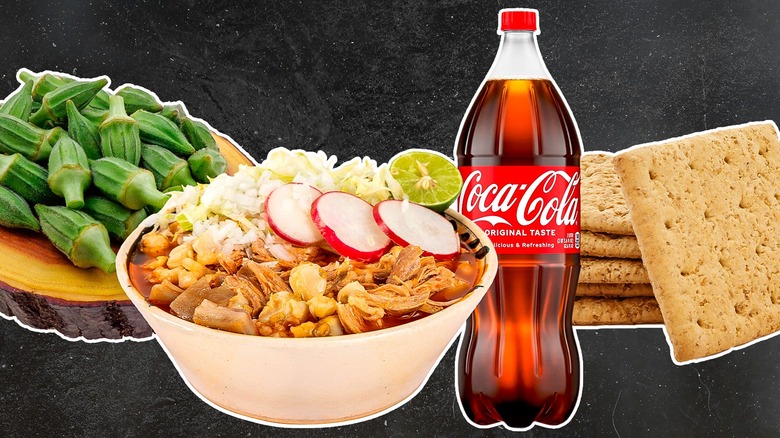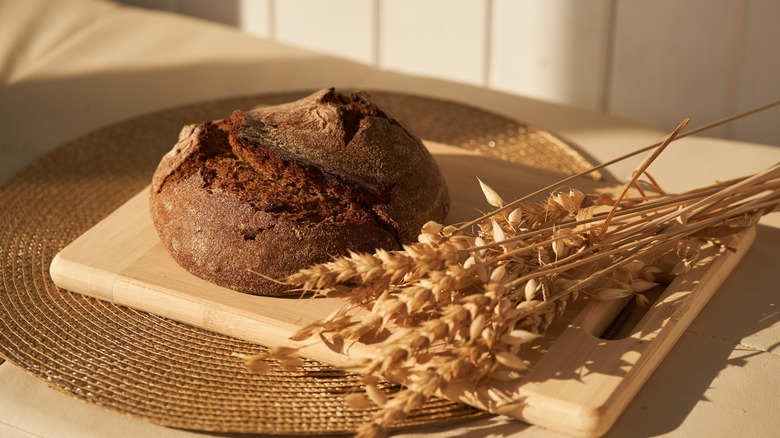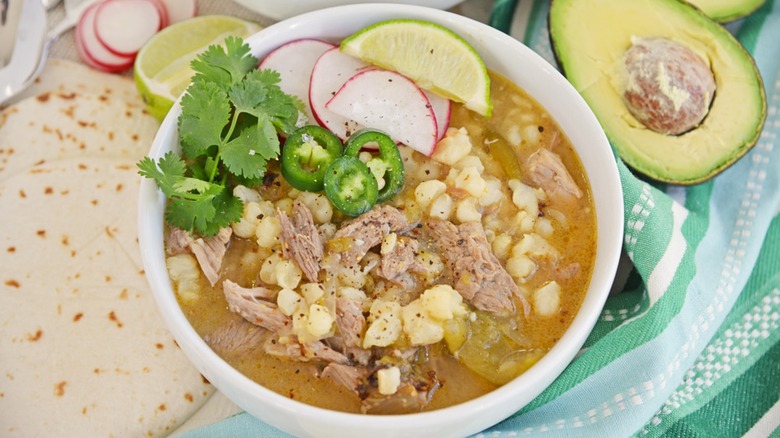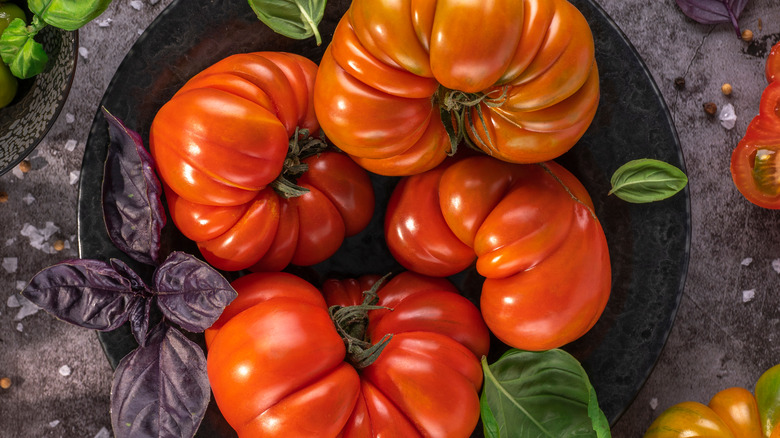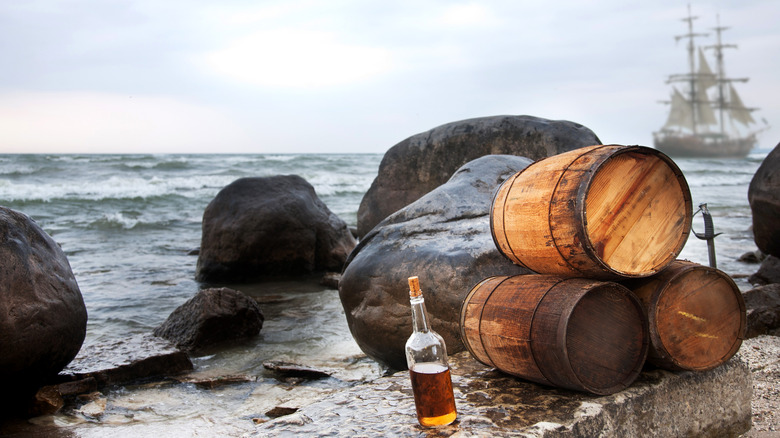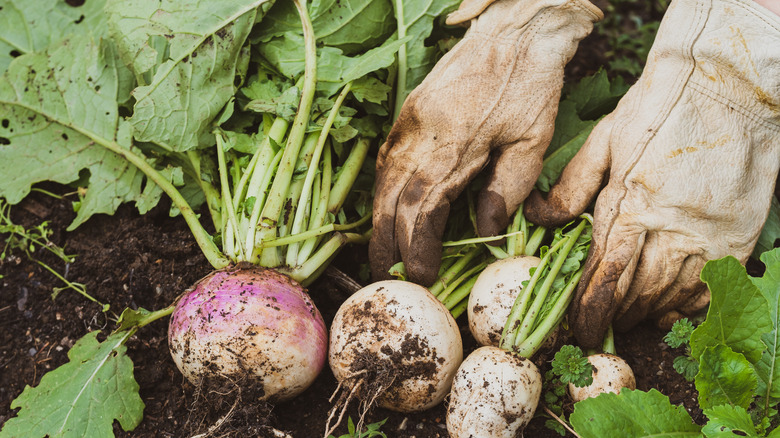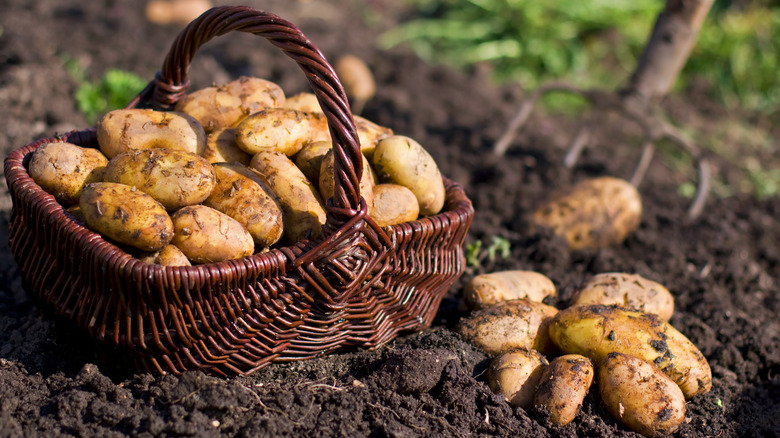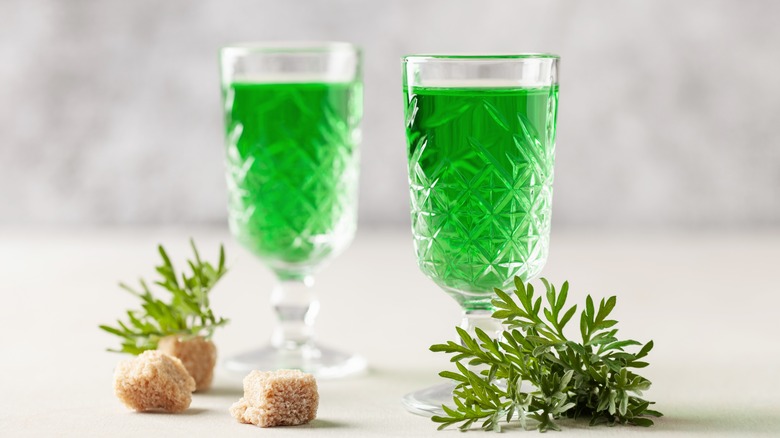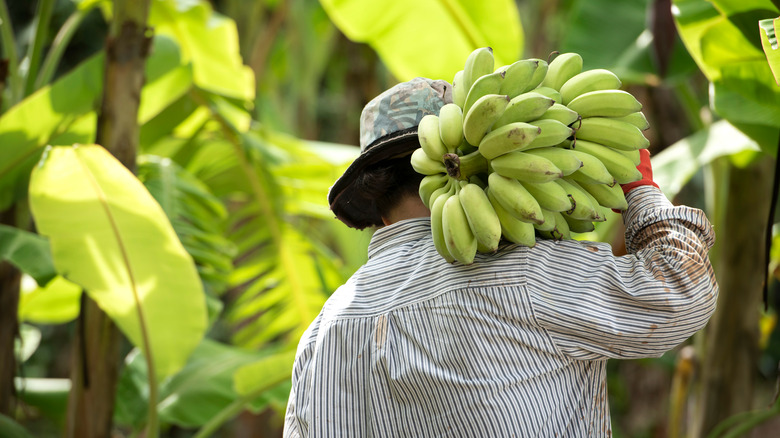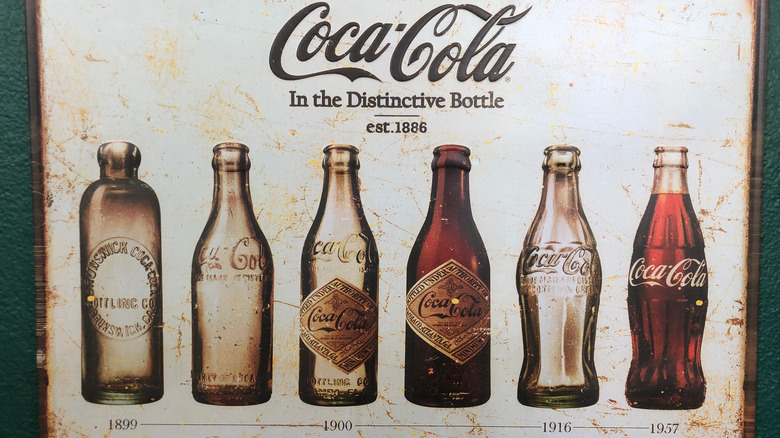15 Foods With A Dark History
While you might not have realized it, many foods we eat every day have a dark history that may make you uncomfortable to read. Some have been misunderstood and wrongfully vilified, while others have killed untold numbers before they were better understood. They've been responsible for miscarriages, infant deaths, and even witches burning at the stake. Many have dark, unsettling pasts connected to drugs, slavery, child labor, massacres, and human sacrifice as well.
You may enjoy some of these foods less next time you remember their dark and often-bloody past. While you might have an inkling about the sordid pasts of Coca-Cola, rum, and sugar, even food like tomatoes, potatoes, and bananas aren't as innocent as they seem. Most of the tragedies connected to the foods on our list have been left behind in history. Unfortunately, one food you've probably enjoyed in the past week is likely still being produced using slavery-level child labor. Prepare to be shocked about what you learn.
1. Rye
Throughout history, rye and other grains have succumbed to a fungus called Claviceps purpurea, which causes ergot poisoning. Ergot poisoning, also known as "St. Anthony's Fire" or the "Devil's Curse," causes people to convulse, spasm, hallucinate, and feel like things are crawling on their skin. Plus, it caused some people's extremities or limbs to turn black, and painfully rot off with gangrene. Ergot poisoning is responsible for numerous deaths and tragic events.
One of the biggest tragedies related to ergot happened over 400 years. Ergot poisoning was responsible for 20,000 to 50,000 deaths in France between 900 and 1300 A.D. It's also responsible for France losing the land that became Germany, since the weakened country was less able to fight off invasions.
It's also thought that ergot was the real cause of the symptoms that led to witch hunts both in Europe during the Dark Ages and in Salem, Massachusetts, in 1692. Not only did ordinary folks in Salem start having ergot poisoning symptoms, but so did the accused "witches." It's possibly because the supposed witches were acting strangely that they were blamed for cursing those around them.
2. Pennyroyal Tea
The history of pennyroyal tea is a sad one. It can be helpful for stomach aches, but this tea made from an herb in the mint family also has a dark side. Cultures from the ancient Romans to the early English have taken pennyroyal orally for everything from upset stomachs, cramps, and gout to colds, respiratory problems, and nervous conditions. While the tannins in it help with upset stomachs, there's no proof it cures other ailments. Not only can it damage many internal organs and nerves, but it can also cause miscarriages.
It's pennyroyal tea's penchant for death and destruction that gives it a dark side. Because it can help with gas and indigestion, pennyroyal tea has often been given to babies for colic. Sadly, it has often caused the babies' liver and nervous system to fail. How people make pennyroyal tea matters, too. Pennyroyal essential oil in amounts as small as half a teaspoon can be toxic to adults, damaging the liver or causing coma or death. Plus, American pennyroyal is doubly as toxic as the European type, which can have deadly results for a person using a European recipe with American pennyroyal.
3. Pozole
If you've ever enjoyed the Mexican soup pozole, you may not have realized it's not the original version of this soup. And be glad that it's not because it was once a cannibal soup.
The dark history behind pozole starts in Mesoamerica with the Aztecs. They called the soup Tlacatlaolli in the Nahuatl language, which means "husked corn of men." This meaty dish included the flesh of those sacrificed to Our Lord the Flayed, Xipe Totec, to celebrate spring, fertility, and bountiful harvests. In their mythology, Xipe Totec fed the first humans with his own skinned flesh. The first European to experience and write about pozole in the 1500s was Spanish historian and missionary Fray Bernardino de Sahagún. He explained that the Aztecs would skin and boil the thighs of warriors from other tribes to make the soup.
Luckily, today's pozole is made from hominy and pork (or sometimes chicken) rather than human thigh meat. It's a wonderfully fresh soup that is served with fresh veggies like cabbage, onions, and radishes, along with lime and salsa. Depending on the type, it may also include chiles or tomatillos.
4. Tomatoes
Tomatoes are native to the Andean area of Mesoamerica. The Aztecs in Mexico cultivated them, so it wasn't until the early to mid-1500s that explorers brought them back to Europe. Unfortunately, because of a major serving error, there was a time when tomatoes gained a reputation in Europe for being poisonous. Indeed, they poisoned some unlucky people to death, but tomatoes alone weren't to blame.
For a while in the 1700s, people called tomatoes "poison apples" after a few wealthy people dropped dead from eating them. Eventually, though, the real culprit was discovered: the aristocrats' plates. Since the plates were made of pewter, the acidic tomato juice on the plate would cause lead to leach out. So, it was really the lead in the plates that were to blame rather than the tomatoes.
There was a belief for a while that the cooler European climate somehow turned tomatoes deadly on the vine. It took about 200 years to clear up the misconceptions. However, even when tomato recipes showed up in newspapers and magazines in the early 1800s in the U.S., some people were still leary of them. Even Ralph Waldo Emerson had the idea that tomato worms could make tomatoes poisonous.
5. Okra
The story of okra starts back in Africa. However, it's the story of how it got to the U.S. that's a dark one. Okra hitched a ride to the U.S. aboard transatlantic slave ships sometime between the 1500s and 1800s. Somehow, while in the middle of being torn from their homes and families to be shipped off to a life of slavery, some Africans thought to gather okra seeds and braid them into their hair for safekeeping. They may not have been able to do much about the horrible fate that was overtaking them, but they could bring an important part of West African cuisine from home with them by secretly transporting seeds like okra.
Eventually, okra would feature strongly in Southern soul food and Creole cooking. Okra grew well in the South, and dishes like fried okra and gumbo all owe their existence to secret okra seed stashes in the hair of a few enslaved individuals.
6. Rum
Rum has a history of being produced by and traded for enslaved Africans. It was one of the many goods exchanged for enslaved people in the Triangle Trade between Africa, the West Indies, and North America in a system that began in the 1500s.
The Triangle Trade used rum extensively. Sailors from New England would sell rum in West Africa in exchange for humans. These enslaved Africans were sold in the West Indies for molasses and money and made to do the labor-intensive work needed to produce molasses from sugarcane. Then, the molasses would be sold in New England to make rum so that the whole Triangle Trade could keep trading rum for people and molasses and rum over and over again.
Sadly, it may have been enslaved people working in the sugarcane business who first created rum by distilling fermented molasses. Thus, it increased the drive to enslave more people to make the popular drink rather than just to fill the world's sugar needs.
7. Sugar
Sugar's dark past is also wrapped up with slavery. After the grueling work of cutting sugar cane by hand with machetes, the sugar cane had to be processed within 24 to 48 hours to avoid spoiling. Thus, slavery made sugar more accessible to the masses. The demand for sugar and the need for people to work for free on sugar plantations was responsible for the enslavement of 10 to 12 million Africans.
Sugar was also part of the Triangle Trade. The trade triangle took goods like copper and cloth from Europe to Africa, where they were used to purchase people, who were taken to the Americas to work making sugar on sugar plantations to be sold back to Europe. Not only did a fourth of those sold into slavery die aboard ship, but those who did arrive in the Americas only tended to live for seven to nine years on sugar plantations because of the dangers involved in production.
8. Turnip greens
Turnips have been around for a long time, but the idea of eating the greens was a byproduct of slavery. Even today, it can be difficult to find turnip greens in grocery stores that carry turnip roots. It's easier to find them in Southern states, where the habit of eating turnip greens has extended beyond soul food into the culinary habits of the general populace.
Turnips are native to Europe. Thus, they came over to the New World with European settlers in the 1600s. However, it was the roots that the settlers had grown up eating, not the greens. So, that's the part of the plant they continued to eat in the New World.
Those who used enslaved Africans to do household and farm work liked to keep choice cuts of meat and the best part of vegetables for themselves while leaving those they enslaved to eat the refuse. So, that left the green leaves for enslaved Africans to eat. Not only were turnip greens nutritious, but they could be made even more hearty and tasty with the addition of discarded meat parts like ham hocks and pig's feet that the enslavers didn't want.
9. Fried catfish
Fried catfish is another food that entered Southern cuisine by way of slavery. What started as an unwanted food has become commonplace today. Catfish was prevalent in the New World, but it was thought of as a trash fish since catfish are bottom feeders and tend to have a muddy taste. The muddy flavor comes from the amount of geosmin they absorb through their gills in the water where they live. These aquatic bacteria and algae are the same thing that make beets have a dirty taste for some people or give a dirty taste to some drinking water. The lower the water quality, the muddier the catfish taste.
Because of the status of catfish as being junk fish, enslavers allowed those they enslaved to have as much of them as they wanted. It was common for the enslaved community to gather at a river or pond to socialize and have a big fish fry with the catfish they caught there. Thus, it entered into soul food cuisine and later made its way into the larger body of Southern cuisine.
10. Potatoes
While the introduction of humble potato as a crop in Northern Europe helped to nearly end famine, it was also the cause of one. Plus, it has been responsible for numerous mass illnesses and deaths.
In 1748, the French government banned potatoes because they were thought to cause leprosy. It was a French prisoner forced to live on potatoes, Antoine-Agustin Parmentier, who began exclaiming the wonders of potatoes once released. Because of his championing of the tastiness of potatoes, France lifted their potato ban in 1772. Unfortunately, the popularity of easy-to-grow potatoes in place of other crops like oats and wheat in Europe led to a particularly dark era in the potato's history. By the 1840s, Ireland had become dependent on potatoes to feed its population. So, when they succumbed to rot from Phytophthora infestans, it caused a famine. One-eighth of the population died because of the country's over-dependence on potatoes that lacked genetic diversity.
Because of the potato's potential to have a high solanine content, it has also been the cause of many mass illnesses and deaths when rotten or eaten green. These have included 56 German soldiers in 1899; 61 people in Glasgow, Scotland, in 1918; a large epidemic in Germany in 1922; seven family members in 1925; hundreds of North Koreans in 1952; 78 students in a boys' school in London in 1979; and 61 children and staff members in a school in Alberta, Canada in 1983.
11. Absinthe
If you've ever tried absinthe, it was probably because you believed the myth that it could cause hallucinations with casual use. It's the hallucinations "myth" that gives it a dark history but perhaps in a different way than you expect.
Absinthe is made from an herb called wormwood, which can cause hallucinations. However, to hallucinate, you'd have to consume the equivalent of a whole wormwood plant. Neither modern nor earlier versions of absinthe from the late 1700s contained enough wormwood to give you hallucinations. If you keep chasing the idea of hallucination in a single setting, you're more likely to succumb to alcohol poisoning than anything else, which was especially true when it was allowed to have 45% alcohol by volume in 1938 France.
Absinthe infused with Artemisia absinthium is currently forbidden in most countries. Consuming this type of wormwood often over time is known to damage the nervous system and cause mental deterioration that would eventually lead to psychotic problems, shaking, and troubles consuming food and drink. Yes, hallucinations and delirium would be part of the problems, too, but more in a capacity of a mental breakdown than a drug-induced stupor. Eventually, it could cause death. Some think that some of Vincent Van Gogh's ailments could be traced back to absinthe poisoning.
12. Bananas
Bananas have a surprisingly dark history. They arrived in the U.S. after being grown in near slave-labor conditions. In fact, the love of this delicious fruit in the U.S. ultimately inspired a massacre.
After appearing in the 1876 World's Fair in the U.S., bananas became so popular that banana companies changed operations to meet demand. The idea was to spend as little as possible to produce even more bananas than ever before. Thus, workers who were getting paid were making very little, but many were only given store vouchers. Plus, they weren't allowed much time for rest.
In 1928, some banana workers in Colombia formed a union and organized a strike to ask for real money and a day off as well as better living conditions and medical care. They'd been asking for better conditions since the late 1910s, but they'd had enough. The U.S. military threatened to act in favor of the workers. However, in solidarity with United Fruit Company and to prevent a revolution, the Colombian government massacred over a thousand of the workers with machine guns.
13. Coca-Cola
The name of one of the world's beloved drinks, Coca-Cola, tells you a bit about its original ingredients. The "Cola" part comes from the inclusion of caffeinated kola nuts, while the "Coca" part comes from the inclusion of coca leaves. Yes, coca leaves are the source of cocaine, and early Coca-Cola actually contained a form of cocaine.
Coca-Cola was first marketed as an elixir to be taken for medicinal purposes. So, how much cocaine was in Coca-Cola when it first came out in the late 1890s? With the formula for Coca-Cola being such a well-kept secret, we'll probably never know. However, it didn't seem to be enough to cause a lot of side effects. The form of cocaine in it was called ecgonine.
Cocaine was legal when Coca-Cola first came out in 1894 and wasn't thought to be harmful. The company eventually removed most of it so that by 1902 an ounce of the syrup used to make the drink only had 1/400 of a grain of cocaine per ounce. By 1929, it had only minuscule traces of cocaine left in it. Even though coca leaves are illegal in the U.S., coca is still an important part of the recipe. A New Jersey company called Stepan Chemical Co. removes all of the cocaine components before coca can be used to make Coca-Cola.
14. 7Up
Did you know that 7Up was initially a tonic created with drugs meant to help treat depression and other mental health issues? The addition of real pharmaceutical ingredients likely contributed to it being more expensive than its competitor soft drinks.
When 7Up first came out in 1929, it had a tongue-twister of a name: Bib-Label Lithiated Lemon-Lime Soda. Yes, "lithiated" means what you think it means; 7Up used to contain lithium citrate. Lithium is commonly prescribed for several manic-depressive mental health issues that cause mood swings, like bipolar disorder, mania, and hypomania as well as schizophrenia and depression.
The name of the drink eventually changed to 7Up Lithiated Lemon. However, when it was forced by law to remove the lithium in 1948, its name became simply 7Up, as we know it today. We wonder how many people had negative side effects when their favorite drink suddenly lost its ability to help lift their moods.
15. Chocolate
The dark history of chocolate extends too far into modern days for comfort. Within your lifetime and possibly even today, the chocolate you eat is likely produced using slavery and child labor.
Child labor for cocoa production is a known problem that has been raging for years. As early as 2001, Nestlé and other chocolate companies like Mars and Hershey started making promises to try to end child labor from its suppliers. However, many such promises have been made and broken year after year. According to the Washington Post, the U.S. Labor Department estimated that 2 million children were being made to work in cocoa production in 2015. As recently as 2019, children from Burkina Faso were being trafficked to work in Ivory Coast cocoa fields as young as age 12.
Not only has child labor been a part of the chocolate production world in the Ivory Coast, but a lot of the child labor is unpaid. Not only have these children enslaved, but they've been subjected to beatings and forced to live in horrible conditions. Suddenly, our chocolate habits seem far less innocent.
